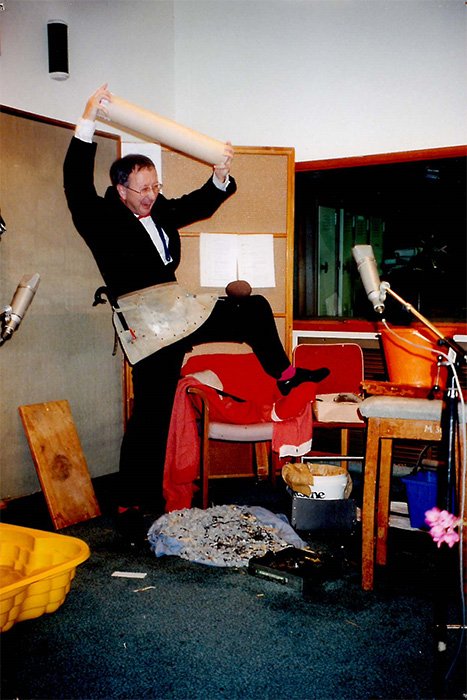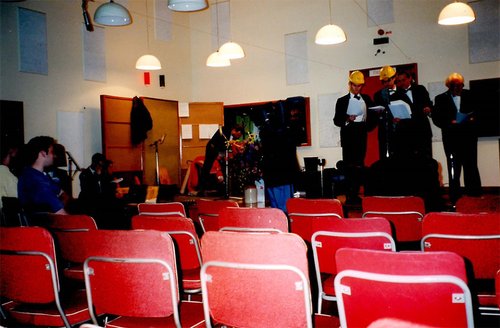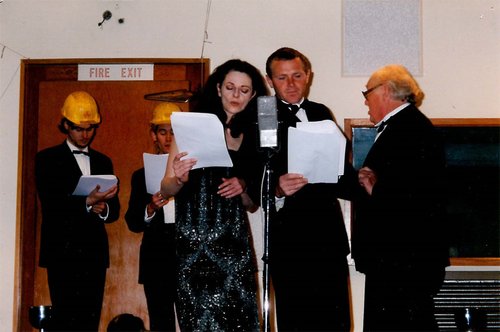
By Gareth Watkins
Dating back to the 1990s, the publicity photographs document some of the country’s top actors performing in a wide variety of radio plays.
One such play – Danger, by Richard Hughes – was performed live on the radio and in front of a studio audience in November 1996, in the now demolished Studio 1 of Broadcasting House. The performance marked the 75th anniversary of radio broadcasting in New Zealand. Not only was all of the dialogue performed live, but so too were the musical moments and the sound effects.
Hero image: "The vintage RCA44 microphone was used for the broadcast. On the piano stool in front, for NO reason, an antique ear trumpet from the drama studio props box.” - Producer of 'Danger', Steve Danby. Cast from left-to-right - five singers including Philip and Nigel Collins; producer Steve Danby; engineer Richard Hulse; Stephen Lovatt; Miranda Harcourt; Bernard Kearns and foley artist Michael Wilson. (November 1996 - Radio New Zealand, Studio 1 – Broadcasting House, Wellington)

Foley artist Michael Wilson generating the live sound effects of a flooding coal-mine “the old-fashioned way.” (November 1996 - Radio New Zealand, Studio 1 – Broadcasting House, Wellington)
The play itself has had a distinguished history. It was the first play ever written for radio, premiering on the BBC on 15 January 1924:
“To my mind, one of the best plays ever broadcast (and I do not say this because I had the pleasure of producing it) was Danger by Mr. Richard Hughes. Here was something that was written for wireless only; the scene was in a coal mine, and was meant to be heard and not seen. If this play had been produced in a legitimate theatre the stage would have been in total darkness; the players and the action would remain unseen.” – Nigel Playfair, Popular Wireless, 9 March 1929
In 1956 author Richard Hughes reflected on the play:
Those were the days of the silent film and our “listening play” (as I dubbed it) would have to be the silent film’s missing half, so to speak, telling a complete story by sound alone… [] We thought of using a narrator but agreed it would be a confession of failure. No, we must rely on dramatic speech and sounds entirely … and it had never been done before.” – Richard Hughes, BBC Home Service, 1956
New Zealand audiences heard the play for the first time on 5 July 1929. It was performed live on air and to an audience at 2YA’s studios in Waring Taylor Street, Wellington. Prior to the broadcast The Radio Record (forerunner to the Listener magazine) warned: “because of its dramatic intensity it is not a play to which young children and those with very weak nerves should listen.”
Elsie Lloyd, a cast member from the 1929 production, was interviewed in 1976 by Peter Harcourt and Davina Whitehouse. In this excerpt Elsie recalls how the sound effects were created:
'Danger by Richard Hughes' - Interview in which Peter Harcourt and Davina Whitehouse talk to Elsie Lloyd, who was a member of the original 1929 cast.

Dress rehearsal of “Danger”. On stage are Nigel and Philip Collins (hardhats), Stephen Lovatt and Bernard Kearns. (November 1996 - Radio New Zealand, Studio 1 – Broadcasting House, Wellington)

Dress rehearsal of “Danger”. On stage are Philip and Nigel Collins (at back), Miranda Harcourt, Stephen Lovatt and Bernard Kearns. (November 1996 - Radio New Zealand, Studio 1 – Broadcasting House, Wellington)
Sources:
Quotes from Nigel Playfair and Richard Hughes were sourced from “Radio Drama at 90,” bbc.co.uk
Audio excerpt from Ngā Taonga Sound & Vision Radio Collection, all rights reserved. To enquire about re-use of this item please contact us.
This post is part of the Audio Curios series. Radio Collection Developer Gareth Watkins regularly comes across interesting, unique, and sometimes downright puzzling bits of audio during his accessioning work. He’s going to share some of these audio treasures with you in the Audio Curios series, which will be posted here on the Gauge blog frequently.